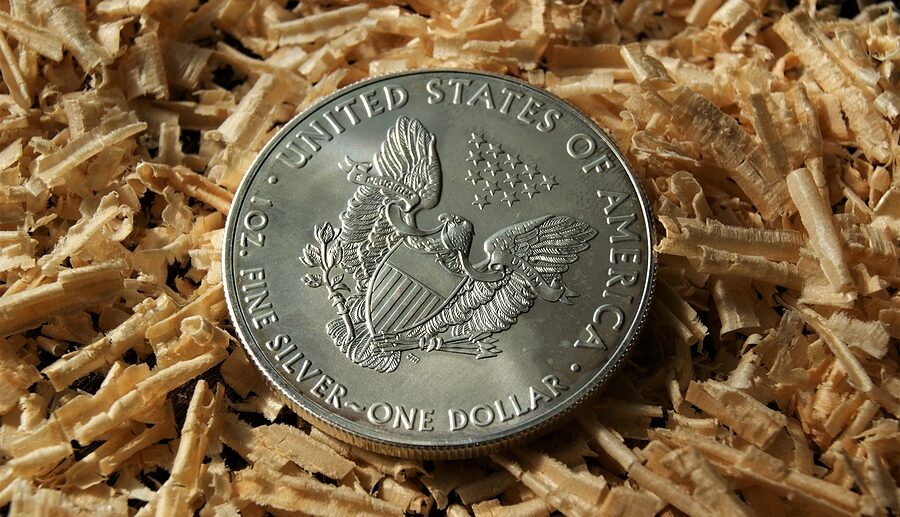
As the official silver bullion coin of the US, the American Silver Eagle receives a lot of attention from both novice and experienced investors. The Silver Eagle is highly sought-after for its high silver purity, consistent market demand, and steady price performance.
It’s well-understood that coins in pristine condition can maintain their value, but are tarnished Silver Eagles still worth money? Understanding how common deterioration impacts the value of this popular coin makes it easier to invest wisely and avoid costly mistakes.
Why do Silver Eagles tarnish?
Silver Eagles tarnish when exposed to sulfur-rich gases including oxygen. The process of tarnishing is a chemical reaction wherein a thin layer of silver sulfide develops on the coin without impacting the layers beneath. The resulting compound shows up as an array of dull discolorations with hues ranging from gold and green to gray and black. Generally, the darker the tarnish, the longer the coin has been subject to the chemical reaction.
It’s common for tarnished Silver Eagles to display a wide range of hues simultaneously depending on how the light hits. This is due to a phenomenon known as thin-film interference where multiple layers of tarnish reflect light in different ways, resulting in a spectrum of colors. You see the same effect on soap bubbles or when oil interacts with water.
Interestingly, pure silver doesn’t tarnish, but it’s too soft to be a practical material for coinage. The American Silver Eagle coin is 99.9% silver, but even the 0.1% of non-silver contents within the Silver Eagle is enough to make these coins vulnerable to tarnishing.
How tarnish impacts the value of Silver Eagles.
Understanding how tarnishing influences the evaluations of Silver Eagles requires a dissection of the expansive variety within this iconic class of coin. So far, over half a billion Silver Eagles have been minted. Since the first mintage in 1986, this coinage has seen iterations of bullion, proof, and uncirculated. The overwhelming majority of Silver Eagles are bullion while only a few hundred thousand fall into the other categories.
Due to their widespread availability, Silver Eagle bullion coins are usually only worth their melt value. Tarnish doesn’t tend to have an impact on the value of these versions since the underlying silver contents remain unaffected. No amount of tarnish, no matter how long it’s left to develop, can destroy a coin’s physical silver content. It might not be aesthetically pleasing, but the inherent silver value will remain intact.
Alternatively, tarnished Silver Eagles in the proof and uncirculated varieties might hold inherent value beyond their weight in silver. These versions undergo a more refined and involved minting process which results in a finer appearance than their bullion counterparts. Since aesthetics play a crucial role in determining the value of these Silver Eagles, tarnishing could negatively impact their value.
👉 Suggested Reading: Proof vs. Uncirculated Coins: What’s the Difference?
Are older Silver Eagles worth more?
While some older versions are worth more than their newer counterparts, this is far from a reliable rule when judging the value of a tarnished Silver Eagle. Age is a crucial factor determining a coin’s value, typically when it denotes historical importance or scarcity. In reality, the sheer number of Silver Eagles minted over the years largely nullifies the impact of age.
Should you clean tarnished Silver Eagles?
No, it’s not advisable to clean tarnished Silver Eagles. In fact, cleaning old coins is never a good idea. In the process of removing discoloration, you could cause irreparable damage to the coin. This may lead to a significant drop in value. Plus, coin collectors and precious metals dealers can usually spot the difference between a coin that’s been kept in excellent condition and a coin that’s been cleaned. It’s also worth noting that any type of cleaning automatically disqualifies a coin from being graded.
Determining the value of tarnished Silver Eagles.
Whether you’re looking to buy or sell tarnished Silver Eagles, you should have an accurate assessment of a coin’s value before taking any action. Since the vast majority of these coins exist in bullion, the discoloration probably won’t have a negative impact. Still, it’s always better to be safe than sorry to make sure you don’t overpay or lose money.
Typically, looking for similar coins online can give you a rough idea of how much a coin might be worth. This isn’t practical when determining the value of tarnished Silver Eagles since all discoloration manifests differently. The most effective and accurate assessment is obtained by consulting with a professional coin dealer or precious metals expert. These specialists can give you an accurate assessment based on a specific coin’s age, mintage type, and condition.
If you’re interested in assessing the value of a Silver Eagle coin or a collection of coins, please reach out to one of our precious metal advisors by calling toll-free at 1-888-812-9892 or by using our live chat function.
👉 Related Read: How to Sell a Coin Collection: 4 Expert Tips

